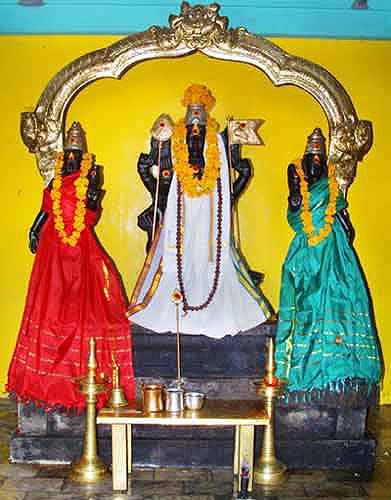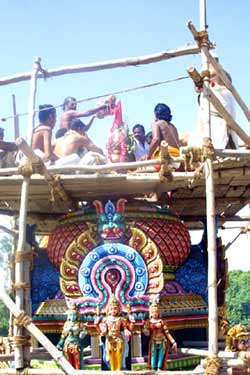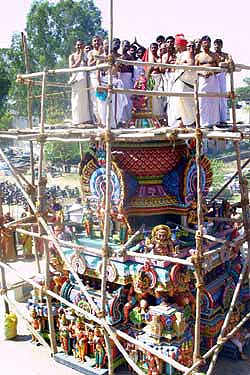
|
|||||||
|
| |||||||
Śrī Karthikeya Swami Temple, Chandigarh
Murugan temple gets a makeover(Times of India, December 22, 2001) CHANDIGARH: Tamils in the city have a task in hand now. They are busy in giving a face-lift to the Murugan temple at the Sector 31-D temple complex. Dedicated to Lord Kartikeyaswami, it is a landmark of sorts as it is the only temple in the city with a gopuram (tower) constructed following the Dravidian architectural style. Lord Murugan Bhakta Samaj, a representative body of the Tamils, has taken up the temple renovation and also the construction of a separate ‘mandir' for Lord Hanuman and Navagrahas (nine planets) within the temple complex. Constructed and consecrated more than a decade ago, the temple has an interesting story. It was during the peak of militancy in Punjab, when some Tamils of the city felt the need for a temple for Kartikeya, who is believed to be a warrior fighting evil, to safeguard the people from the militants. First a small temple was built at the place where the present temple stands. The renovation work of the temple is necessitated as per the Hindu traditions, according to which, after every 12th year, a temple should be consecrated and its domes should be washed with sacred waters drawn from various perennial rivers (the process known as Kumbabishekam). The Samaj has planned to perform the Kumbabishekam in April 2002, coinciding with Ramnavami. Thiagarajan Stapathi of Tamil Nadu, who is currently involved in temple constructions at various places in India and also in Australia and Malaysia, is overseeing the construction work of the new Hanuman and Navagrahas temples here. Though based in Chennai, he makes a frequent visit to the temple complex. Rajagopala Stapathi (Thiagarajan is his disciple) was the main architect behind the construction of the entire temple, who also prepared the blueprint for the current renovation works before his sudden demise in January 2001. "The construction of new temples will also be as per the south Indian architecture like the main one," says Rajashekar, the secretary of the Samaj. The idols of Hanuman and nine Navagrahas will come from Mahabalipuram, in Tamil Nadu, for which orders are already been placed. The idols are likely to arrive here before the end of March 2001, according to temple sources. The long delay in getting idols is due to its various treatment procedures, before being installed for worshipping. "As per the vigraha sashtra, the idols after being sculpted will have to be submerged under water for a month and then in nine types of cereals (Navadanya)," says Rajashekar. The man who gives shelter to Gods
(Article published in Times of India on April 8, 2002) CHANDIGARH: He has taken up a task to keep alive the century-old tradition of Dravidian architecture and to build as many shelters as possible for God not only in India but also abroad. In this course, he has introduced several innovative designs in temple architecture, and the city is lucky to have one such at Śrī Karthikeya Swami Temple, Sector 31-D. Meet the chief architect Thiyagarajan Sthapathi, who is currently being involved in giving a face-lift to the temple, which he had built about 12 years ago. The temple is due for the Mahakumbhabhishekam (consecration) on April 29. This dhoti-clad, simple-looking person from Chennai has carved out hundreds of temples in south India and also countries like Australia, Malaysia, Singapore, Mauritius, Sri Lanka and South Africa, following the traditional architecture with different styles pertaining to chola, pallava and pandiya dynasties. Detailing about the temple, he says, "The temple in Chandigarh is the third such temple designed and built by me in such a way to provide devotees the pleasure of viewing both the vimhanam (tower) as well as the main idol at one sight, a practice which has been mentioned in puranas as a good omen to ward off ones sin. (The other two temples are in Tamil Nadu) It is also one of the very few temples in India whose tower has been built adopting both Chola and Pallava styles of temple architecture." A disciple of Rajagopala sthapathi, Thiyagarajan has been in this profession for the last 25 years. He did his five-year diploma in temple architecture from the College of Architecture in Mahabalipuram, Tamil Nadu. "The temple's peripheral walls will be adorned with several sculptures of Ganesha, Shiva and Parvathi, peococks and mushikas (vehicles of Lord Karthikeya and Ganesha) and lions. All these idols are hand-made using cement and bricks as base and finished with marble powder for durability and long life. Instead of conventional hand cast shapes, we use fibre dye to cast different shapes for the decoration purpose which gives good finish," he says. Impressed by his work, a temple in Sector 42 and Balaji mandir in Panchkula have approached him to make similar sculptures in their temples too. Though he has made only temples of Hindu faith, he says, "I can also design and construct churches and mosques. I have made a blue print for a church in Kerala and hope to start its work soon." On the work to be completed in Sector 31-D, he says, "The painting of tower has been completed and we are now working inside the santum santoram, which is very crucial involving maximum care. The old plaster has to be replaced by the new one. After this, the idols of Lord Hanuman and Navagraha will be installed on a separate pedestal after applying a mixture of eight kinds of medicinal herbs below each idol. This is an old custom to clear off poisonous insects from entering into temple." According to Ramalingam, treasurer of Lord Murugan Baktha Samaj, a religious body, undertaking the renovation work, "the main santum santoram will be purified before consecration. For this, a team of priests headed by Rajappa Gurukkal from Kanchipuram is reaching the city on April 19." The idols of Lord Hanuman and navagraha (nine planets) made of rocks are expected to reach the city soon from Mahabalipuram, according to temple sources. Re-uniting celestial power with earthChandigarh Times on April 29, 2002) CHANDIGARH: He has come all the way from Kanchipuram in Tamil Nadu to the city for a sole purpose: to re-consecrate Kartikeya Swami Temple in Sector 31 D on Monday. Heading a group of 15 shivacharyas, Rajappa Gurukkal is an expert of sort in temple shastras. He is also a shivacharaya (a position just below that of shankaracharyas) and has been instructed by Shankaracharya of Kanchipuram Śrī Jayendra Saraswati Swamigal to perform the Mahakumbabishekam (consecration) of the temple. While talking to him, he explains about the significance of consecration of temple. What is the purpose of re-consecrating a temple?As per the temple shastra, the power in idols, particularly made of black stone, gradually gets reduced in about 12 years time. We call the whole consecration process ashtabandan (mix of eight ayurvedic herbs) kumbabishekam. That means, the main idol of the temple, which is a source of celestial powers and its pedestal, which carries power from earth are made to unite using a medium called ashtabandan. Like medicines, whether it is ayurvedic or allopathic, these ashtabandan too have ‘expiry date' of about 12 years. So, re-consecration is needed to re-install the powers back into the idol through vedic means and also using a new mix of ashtabandan. What processes are to be done before consecrating a temple?It is as good as giving a new look to the temple as a whole, from painting the outer wall to cleaning the sanctum sanctorum and applying a paste of sandalwood over the walls above the idols. After all this done, whatever little power is left within the main idol should be re-located to another place before sanctifying the temple. The process is called palalayam, which was conducted by priests drawn from Delhi, on April 16. Since installation of Hanumanji and Navagraha (nine planets) idols are also planned for April 29, the idols, which were brought from Mahabalipuram, were given special treatment by keeping it on nine cereals and also under water separately for about a week, as a part of the purification process. The consecration process begins with vigneswara puja and vasthu hawan, followed by special pujas to copper vessels (kalas) containing sacred waters drawn from all the perennial rivers across India. The water then will be poured over the domes of temple tower and also on all the idols simultaneously, which marks the culmination of the consecration. Why should the towers also be re-consecrated?The tower is sanctified to enable people, who could not visit the temple due to illness or other reasons, to worship from a distance. Also, God is omnipresent. To focus the power in one place so that people can gather and worship, our ancestors had made it mandatory to sanctify towers too, through the same vedic means applicable for idols inside the temple. Kartikeya temple consecratedArticle No: 4 appeared in Chandigarh Times on April 30, 2002 CHANDIGARH: The weeklong celebrations at Kartikeya Swami Temple, Sector 31D culminated with the consecration of the main temple and installation of Lord Hanumanji and Navagraha (nine planets) inside the temple complex, on Monday. Priests, drawn from Kanchipuram in Tamil Nadu, claimed the temple tower and poured the sacred waters brought from all the perennial rivers across India over the shining dome amidst chanting of vedic hymns by Shivacharyas, while hundreds of devotees relentlessly reciting Muruga Muruga…(one of the names of Lord Kartikeya) standing below the temple tower. Lord Murugan Baktha Samaj had made all the arrangement for the consecration, which has been carried out once in 12 years. According to Rangarajan, the president of consecration committee, "The building has been restructured in such way as to accommodate more devotees. Also, with the construction of a new stage and mandap inside the complex, the temple can now play host to dance and music events and also to various cultural activities." For details about Śrī Karthikeya Swami Temple, Chandigarh, contact Rama Nathan ramaknathan@yahoo.com or write to: Lord Murugan Bhaktha Samaj Śrī Karthikeya Swami Temple home page | Photos of Śrī Karthikeya Swami Temple | Index of Murugan Temples
| |||||||


